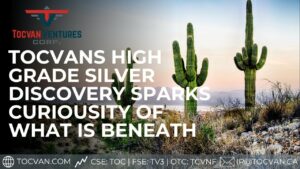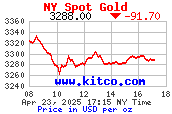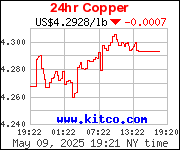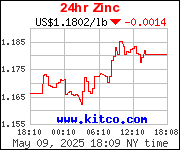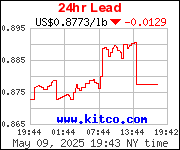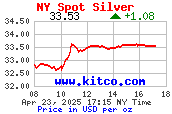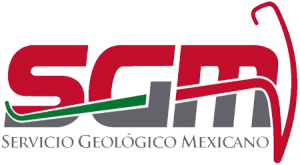TORONTO, ONTARIO–(Marketwired – Jan. 11, 2018) – Alamos Gold Inc. (TSX:AGI)(NYSE:AGI) (“Alamos” or the “Company”) today reported fourth quarter and annual 2017 production. The Company also provided 2018 production and operating guidance.
“With record fourth quarter gold production, Alamos achieved a new annual record, producing 429,400 ounces of gold, while delivering a significant reduction in operating costs and capital spending. This translated into strong free cash flow growth from our operations,” said John A. McCluskey, President and Chief Executive Officer.
“We significantly improved our outlook over the past year. With a stable operating base of 500,000 ounces of annual production, improving margins, near term growth, and a peer-leading, debt free balance sheet, we are well positioned to deliver significant free cash flow growth over the next several years,” Mr. McCluskey added.
Fourth Quarter and Full Year 2017 Operating Highlights
- Record annual production: Produced a record 429,400 ounces of gold in 2017 marking a 10% increase from 2016. This includes approximately one month of production from Island Gold following completion of the Richmont acquisition. Excluding Island Gold, the Company produced 420,400 ounces, above the mid-point of production guidance
- Decrease in costs: All-in sustaining costs for 2017 have not been finalized but are expected to be consistent with full year guidance of $940 per ounce (excluding Island Gold), representing a 7% decrease from 2016
- Record fourth quarter: Produced a record 120,300 ounces of gold in the fourth quarter, including a record 56,500 ounces from Young-Davidson, 42,700 ounces from Mulatos, 12,100 ounces from El Chanate and 9,000 ounces from Island Gold (following completion of the Richmont acquisition on November 23, 2017)
- Record sales: Sold a record 126,786 ounces of gold in the fourth quarter of 2017 at an average realized price of $1,275 per ounce for record revenues of approximately $162 million
2018 Guidance Overview
- Significant production growth: Production guidance of 480,000 to 520,000 ounces of gold, a 16% increase over 2017 (based on the mid-point of guidance) reflecting the inclusion of Island Gold
- Strong operating margins: Consolidated all-in sustaining cost guidance of $950 per ounce, consistent with 2017 guidance which was down approximately 7% from 2016. Excluding El Chanate, all-in sustaining costs are expected to decrease to $920 per ounce in 2018
- Stable capital spending at operating mines: Capital budget for operating mines of $146 to $165 million, up from 2017 reflecting the inclusion of Island Gold, partially offset by lower spending at Mulatos with the development of La Yaqui Phase I complete. The capital budget for Young-Davidson is consistent with 2017
- Development project spending focused on Kirazli and exploration at Island Gold and Mulatos: Total capital budget for development projects of $146 million, the majority of which is focused on construction of the Kirazli project and capitalized exploration at Island Gold and Mulatos
- Peer-leading balance sheet and free cash flow from operations to fund growth: With stronger mine-site free cash flow and cash and equity securities of approximately $235 million at the end of 2017, Alamos is well positioned to fund development of its growth assets
- Increased exploration budget: Global exploration budget of $36 million, up 50% from 2017 with nearly 80% of the spending to be focused on Island Gold and Mulatos
- Corporate G&A among lowest in peer group: Corporate and administrative expenses are expected to total $18 million (excluding share based compensation), or $36 per ounce (based on the mid-point of guidance) among the lowest within the intermediate gold producer peer group
Outlook to 2020
- Stable production base from operating mines: Combined annual gold production from existing operations is expected to be above 500,000 ounces in 2019 and 2020 (excluding Kirazli) with low cost production growth at Island Gold offsetting declining higher cost production from El Chanate
- Declining cost profile: Consolidated all-in sustaining costs are expected to decrease in 2019 driven by the completion of the Phase I expansion at Island Gold and the end of the 5% NSR royalty at Mulatos, with a further decrease expected in 2020 reflecting higher underground mining rates at Young-Davidson
- Reduced capital spending at operating mines: Capital spending at existing operating mines is expected to trend lower in 2019 and 2020 reflecting the completion of both the Phase I expansion at Island Gold and lower mine infrastructure at Young-Davidson
- Significant free cash flow growth from operations: The Company expects strong free cash flow growth from its operations over the next three years, reflecting a declining cost profile and lower capital spending
- Strong production growth from development pipeline: Pending receipt of final permits, construction of the Kirazli project will continue through 2018 with initial production expected in the second half of 2019 and more than 100,000 ounces of low cost production growth in 2020. This would bring consolidated gold production above 600,000 ounces in 2020, representing more than 20% production growth from 2018, while further decreasing the company-wide cost profile
| Fourth Quarter and Full Year 2017 Operating Results | |||||
| Three months ended | Twelve months ended | ||||
| December 31, 2017 | December 31, 2016 | December 31, 2017 | December 31, 2016 | ||
| Gold production (ounces) | |||||
| Young-Davidson | 56,500 | 44,662 | 200,000 | 170,000 | |
| Island Gold(1) | 9,000 | – | 9,000 | – | |
| Mulatos | 42,700 | 44,900 | 160,000 | 154,000 | |
| El Chanate | 12,100 | 16,114 | 60,400 | 68,000 | |
| Total gold production | 120,300 | 105,676 | 429,400 | 392,000 | |
| (1) | Operating results from Island Gold have been included from November 23, 2017 following completion of the Richmont Mines acquisition. Including results prior to the completion of the acquisition, Island Gold produced 22,100 ounces of gold in the fourth quarter of 2017 (24,086 ounces in the fourth quarter of 2016) and 98,600 ounces for the full year (83,323 ounces in 2016). |
2018 Guidance
Strong production growth and decreases in costs and capital spending resulted in a significant increase in mine-site free cash flow in 2017. Strong mine-site free cash flow is expected to continue in 2018 driven by an expected 16% increase in gold production. The Company expects stronger gold production, lower costs and a lower rate of capital spending in the second half of 2018, all of which is expected to contribute to higher mine-site free cash flow compared to the first half of the year.
| 2018 Guidance | 2017 Guidance | ||||||
| Young-Davidson | Island Gold | Mulatos | El Chanate | Total | Total | ||
| Gold production (000’s ounces) | 200-210 | 90-100 | 150-160 | 40-50 | 480-520 | 429 (actual) | |
| Cost of Sales (in millions) (1) | $220 | $112 | $147 | $57 | $536 | $442 | |
| Cost of Sales ($/oz) (1) | $1,075 | $1,175 | $950 | $1,270 | $1,075 | $1,065 | |
| Total cash costs ($/oz) (2) | $675 | $575 | $800 | $1,200 | $740 | $765 | |
| All-in sustaining costs ($/oz) (2) | $950 | $940 | |||||
| Mine-site all-in sustaining costs ($/oz) (2),(4) | $850 | $825 | $900 | $1,200 | – | – | |
| Capital expenditures (in millions) | |||||||
| Sustaining capital(2) | $35-40 | $25-27 | $8-10 | – | $68-77 | $40-47 | |
| Growth capital(2) | $35-40 | $25-28(3) | $18-20(3) | – | $78-88 | $65-75 | |
| Total capital (2) | $70-80 | $50-55 | $26-30 | – | $146-165 | $105-122 | |
| Corporate & Administrative (in millions) | $18 | $16 | |||||
| (1) | Cost of sales includes mining and processing costs, royalties, and amortization expense. |
| (2) | Refer to the “Cautionary non-GAAP Measures and Additional GAAP Measures” disclosure at the end of this press release for a description of these measures. |
| (3) | Excludes capitalized exploration. |
| (4) | For the purposes of calculating mine-site all-in sustaining costs at individual mine sites, the Company does not include an allocation of corporate and administrative and share based compensation expenses to the mine sites. |
The 2018 production forecast and operating cost estimates are based on the following currency assumptions:
| 2018 Currency Operating Assumptions | ||
| United States dollar:Canadian dollar foreign exchange rate | $0.78:1 | |
| Mexican peso:United States dollar foreign exchange rate | 18:1 | |
The Company has entered into foreign exchange transactions representing approximately 65% of its Canadian dollar-denominated operating and capital costs in the first half or 2018 (35% of its full year exposure), ensuring a maximum USD/CAD foreign exchange rate of $0.76:1 and allowing the Company to participate in weakness in the USD/CAD up to a rate of $0.72:1. Approximately 95% of the Company’s operating and capital costs at its Canadian operations are Canadian dollar denominated. Excluding the impact of hedges, a $0.05 (6.5%) change in the USD/CAD foreign exchange rate will impact free cash flow by $22 to $25 million in 2018.
The Company has entered into foreign exchange transactions representing approximately 70% of its Mexican peso-denominated operating and capital costs in 2018, ensuring a minimum MXN/USD foreign exchange rate of 18.5:1 and allowing the Company to participate in weakness in the MXN/USD up to a rate of 20.3:1. Approximately 40% of the Company’s operating and capital costs at its Mexican operations are Peso denominated. Excluding the impact of hedges, a 1 (5.5%) Peso change in the MXN/USD foreign exchange rate will impact free cash flow by $5 to $7 million in 2018.
Young-Davidson
Gold production at Young-Davidson is expected to range between 200,000 and 210,000 ounces in 2018. Mine-site all-in sustaining costs are expected to average $850 per ounce of gold sold, up slightly from average costs through the first three quarters of 2017 of $824 per ounce reflecting the stronger Canadian dollar and a higher proportion of sustaining capital versus growth capital (total capital budget for 2018 is unchanged from 2017). Total cash costs are expected to average $675 per ounce.
Underground mining rates are expected to increase to an average rate above 7,000 tonnes per day (“tpd”) in 2018, up from an average of approximately 6,600 tpd in 2017. Underground mined grades are expected to be consistent with the Mineral Reserve grade at 2.69 g/t Au in 2018, though can vary as much as 10% from quarter to quarter. Mill throughput is expected to average 7,800 tpd, up from 7,500 tpd in 2017. Milled grades are expected to range between 2.45 and 2.55 g/t Au with lower grade surface stockpiles continuing to supplement higher grade underground ore. Mill recoveries are expected to range between 90 and 92%.
Capital spending at Young-Davidson remains on track with a 2018 budget of between $70 and $80 million, including $35 to $40 million of sustaining capital. Capital spending in 2018 will be focused on the ongoing upper and lower mine development and lower mine infrastructure. The Company expects stronger free cash flow in the second half of the year reflecting higher production rates and lower capital spending.
Looking forward to 2019, gold production is expected to decrease marginally, reflecting approximately six weeks of downtime of the Northgate shaft to complete the tie in of the upper and lower mines which will temporarily limit underground throughput. This is expected to occur in the fourth quarter of 2019 following which underground mining rates are expected to ramp up above 7,500 tpd. This is expected to drive annual gold production above 200,000 ounces in 2020. Combined with declining costs and capital spending, the Company expects further free cash flow growth from Young-Davidson in 2020.
Island Gold
Island Gold is expected to produce 90,000 to 100,000 ounces of gold in 2018, consistent with the Phase I expansion preliminary economic assessment (“PEA”) released in 2017. Mine-site all-in sustaining costs are expected to average $825 per ounce of gold sold, up from 2017 reflecting higher sustaining capital; however, below what was outlined in the PEA despite the stronger Canadian dollar. Total cash costs are expected to average $575 per ounce.
The Phase I expansion of the mill to 1,100 tpd remains on track and is expected to be completed in the second half of 2018. This is expected to drive strong production growth and lower costs in the fourth quarter and into 2019.
Underground mining rates are expected to average 1,000 tpd. Mill throughput is expected to average 980 tpd over the full year with higher throughput rates in the fourth quarter following completion of the mill upgrades. Milled grades are expected to range between 8.3 and 8.9 g/t Au. Mining and milling rates and grades processed are all expected to be consistent with the PEA. Mill recoveries are expected to range between 96 and 97%.
The Phase I expansion remains on track with a 2018 capital budget for Island Gold of between $50 and $55 million, consistent with the PEA. This includes sustaining capital of between $25 and $27 million. Capital spending will be focused on ongoing underground development and upgrades to the milling circuit. Higher gold production and lower costs are expected to drive strong free cash flow growth in the second half of 2018.
Capital spending is expected to decrease in 2019. Combined with higher gold production and lower costs, this is expected to translate into significant free cash flow growth.
In parallel to the Phase I expansion, the Company will continue an aggressive exploration program at Island Gold which has been successful in driving a more than 300% increase in Mineral Reserves and 44% increase in grade since 2014. Ongoing exploration success will be incorporated into an evaluation of the most effective and economic approach to a Phase II expansion of the operation beyond 1,100 tpd.
Mulatos District
Total production from the Mulatos district (including La Yaqui Phase I) is expected to be between 150,000 to 160,000 ounces of gold in 2018, consistent with 2017. Mine-site all-in sustaining costs are expected to average $900 per ounce of gold sold and total cash costs $800 per ounce, both consistent with 2017 guidance.
Open pit grades mined and stacked on the heap leach pad are expected to range between 0.75 and 0.95 g/t Au (including La Yaqui) with stacked grades to increase through the year. The combined operating waste to ore ratio is expected to range between 0.7 and 0.9:1.
Total crusher throughput (excluding mill throughput) is expected to increase to an average 20,000 tpd in 2018, up from 18,500 tpd in 2017 reflecting a full year of production from La Yaqui Phase I. The combined recovery ratio is expected to average 75%.
The Company expects one quarter of production from the high grade mill with the underground San Carlos deposit and high grade surface stockpiles scheduled to be depleted by the end of the first quarter of 2018.
Capital spending at Mulatos is expected to total $26 to $30 million including $8 to $10 million of sustaining capital. This is down from the 2017 budget of $33 to $40 million with development of La Yaqui Phase I complete.
Additionally, $13 million has been budgeted for the development of La Yaqui Grande and Cerro Pelon. Spending will be focused on engineering, permitting and early stage construction activities.
Total production from the Mulatos district is expected to remain in a similar range of 150,000 to 160,000 ounces of gold per year between 2018 and 2020, at declining costs. The decline will be driven in part by the end of the 5% NSR royalty at Mulatos in early 2019. Approximately 210,000 ounces remain subject to the royalty after which costs will decrease by $65 per ounce (assuming spot gold prices of $1,300 per ounce).
El Chanate
El Chanate is expected to produce 40,000 to 50,000 ounces of gold in 2018. This is down from 60,400 ounces produced in 2017 reflecting lower mining rates with mining activities expected to cease mid-2018. Total crushed and run of mine ore is expected to average 9,700 tpd with an average processed grade of 0.69 g/t Au.
Mine-site all-in sustaining costs are expected to average $1,200 per ounce of gold sold; however, the Company expects strong cash flow growth once mining activities cease.
Given the long leach cycle at El Chanate, the Company expects to benefit from ongoing gold production beyond 2018 through residual leaching of the pad. This will be lower cost and higher margin production with mining activities completed and is expected to drive higher mine-site free cash flow from the operation.
To ensure El Chanate remains free cash flow positive, the Company has hedged all of its expected 2018 gold production through gold collar contracts. This will provide a minimum realized gold price of $1,270 per ounce and participation up to a price of $1,444 per ounce.
| 2018 Global Operating and Development Budget | |||||
| 2018 Guidance | 2017 Guidance | ||||
| Sustaining Capital | Growth Capital | Total | Total | ||
| Operating Mines (in millions) | |||||
| Young-Davidson | $35-40 | $35-40 | $70-80 | $70-80 | |
| Island Gold | $25-27 | $25-28 | $50-55 | – | |
| Mulatos(1) | $8-10 | $18-20 | $26-30 | $33-40 | |
| El Chanate | – | – | – | $2 | |
| Total – Operating Mines | $68-77 | $78-88 | $146-165 | $105-122 | |
| Development Projects (in millions) | |||||
| Turkey | – | $100 | $100 | $4 | |
| Lynn Lake | – | $8 | $8 | $9 | |
| La Yaqui Grande & Cerro Pelon | – | $13 | $13 | – | |
| Esperanza & Quartz Mountain | – | $2 | $2 | $3 | |
| Total – Development Projects | – | $123 | $123 | $16 | |
| Capitalized Exploration (in millions) | |||||
| Island Gold | – | $12 | $12 | – | |
| Mulatos | – | $7 | $7 | $15 | |
| Lynn Lake | – | $4 | $4 | $4 | |
| Total – Capitalized Exploration | – | $23 | $23 | $19 | |
| Total Consolidated Budget | $68-77 | $224-234 | $292-311 | $140-157 | |
| (1) | Excludes development capital for Cerro Pelon and La Yaqui Grande in 2018. |
2018 Capital Budget for Development Projects
Capital spending on the Company’s development projects, including capitalized exploration, is expected to total $146 million in 2018, the bulk of which is focused on construction of the Kirazli project. The remainder of the spending is comprised of capitalized exploration at Island Gold, Mulatos and Lynn Lake and advancing permitting and development of Cerro Pelon, La Yaqui Grande and Lynn Lake.
Kirazli Development Budget
The 2018 capital budget for Kirazli is $100 million which will be focused on construction and development of the project. Development activities including power line construction, tree clearing and road relocation began in the second half of 2017 and will continue into 2018. The Company is in the process of awarding several key contracts which will comprise the bulk of the spending in 2018. These include civil works and the water reservoir with major construction activities expected to ramp up in the more favourable spring weather.
The Company has been granted the Environmental Impact Assessment and Forestry Permits for Kirazli and continues to pursue the GSM (Business Opening and Operation) permit. Approximately 80% of the 2018 budget is contingent upon and will be spent following receipt of the GSM permit. The remainder of Kirazli’s initial capital will be spent in 2019 with initial gold production expected in the second half of 2019. Kirazli is expected to produce more than 100,000 ounces of gold in its first full year of production at mine-site all-in sustaining costs of less than $400 per ounce. This is expected to drive company-wide production growth of more than 20% between 2018 and 2020, while significantly lowering the Company’s cost profile.
Cerro Pelon and La Yaqui Grande Development Budget
The capital budget for Cerro Pelon in 2018 is $8 million which will be spent on engineering, permitting and early stage construction activities. The Cerro Pelon deposit is located approximately three kilometres from the existing Mulatos operation. Given its proximity to Mulatos’ infrastructure, ore from the Cerro Pelon open pit is expected to be trucked to the existing heap leach circuit for processing. The environmental impact assessment (“MIA”) for Cerro Pelon is expected to be finalized and submitted mid-2018. Following approval, construction and pre-stripping activities are expected to take approximately 18 months with initial production expected in 2020.
La Yaqui Grande’s capital budget for 2018 is $5 million with spending focused on permitting and project engineering. The MIA is expected to be completed and submitted by the end of 2018 with construction and pre-stripping activities commencing in the latter part of 2019 and production in 2021. Similar to La Yaqui Phase I, La Yaqui Grande will be developed as a standalone, open pit, heap leach operation. La Yaqui Grande has seen significant growth in its Mineral Reserves over the past two years and remains an exploration focus. As such, the MIA preparation and engineering work is being conducted to accommodate further potential Mineral Reserve growth beyond the currently defined Mineral Reserve of 521,000 ounces (11.5 million tonnes grading 1.4 grams per tonne of gold).
Lynn Lake Development Budget
The 2018 capital budget for Lynn Lake is $12 million, comprised of $8 million for development activities and $4 million for exploration. Development spending will be focused on baseline work in support of the Environmental Impact Study (“EIS”) for the project that will be submitted to satisfy federal and provincial EA requirements. The permitting process is expected to take approximately two years followed by two years of construction. The Company will also be evaluating various opportunities to enhance the project’s economics as outlined in the December 2017 Feasibility Study. This includes incorporating exploration success over the past year and ongoing results with a further $4 million budgeted for exploration in 2018.
2018 Exploration Budget
The global 2018 exploration budget is $36 million, representing a 50% increase over the 2017 budget. The driver of this increase is the addition of Island Gold with $15 million budgeted as part of an aggressive ongoing exploration program which has driven significant Mineral Reserve and Mineral Resource growth over the past several years. Mulatos continues to be a key exploration focus with $13 million budgeted. Lynn Lake will also be a focus with approximately $4 million budgeted to follow up encouraging exploration results from the past year which have not been incorporated into the December 2017 Feasibility Study. Approximately 65% of the 2018 budget will be capitalized.
Island Gold
A total of $15 million and 84,000 metres (“m”) has been budgeted for exploration at Island Gold in 2018 as part of an aggressive ongoing exploration program which saw similar spending in 2017. A key focus over the past year was expanding the Mineral Reserve base within the PEA expansion area through delineation drilling. The Company has had good success through 2017 with several previously unreleased holes in the main C Zone including (all true width and calculated using a 225 g/t Au capping value):
- 94.97 g/t Au over 3.83 m (840-529-24);
- 62.85 g/t Au over 4.72 m (840-529-13);
- 109.01 g/t Au over 2.55 m (840-524-23); and
- 14.82 g/t Au over 10.03 m (860-509-10).
This delineation drilling will continue through 2018 and 2019 with a focus on upgrading the large Mineral Resource base both within the PEA expansion area and outside it.
The other key focus has been on continuing to test mineralization laterally and at depth with the ultimate goal of adding to the large near mine Mineral Resource base. New highlight intercepts from the second half of 2017 include (all true width and calculated using variable capped gold values):
- 13.32 g/t Au over 12.18 m (MH11, E1E Zone);
- 10.58 g/t Au over 5.44 m (740-465-63, C Zone);
- 23.71 g/t Au over 2.86 m (840-524-18, C Zone);
- 25.92 g/t Au over 6.80 m (340-587-02, G6 Zone); and
- 22.28 g/t Au over 7.71 m (740-465-45, X Zone).
See Figure 1 for locations of the above noted intercepts and Tables 1 to 3 at the end of this press release for additional previously unreleased highlights from the 2017 drill program at Island Gold and for additional information on capping values.
The 2017 program has been successful in outlining additional mineralization both laterally and at depth with the majority of exploration drill results not yet at the required drill spacing to allow inclusion in the Inferred Mineral Resource category.
The 2018 exploration program will be focused on upgrading these exploration results into Inferred or Indicated status, further drilling to test the limits of the mineralization at depth, both to the west and east, and first pass drilling over the five to six kilometre long strike extent of the Goudreau Deformation Zone to the east of the main Island Gold Deposit.
Mulatos
A total of $13 million and 41,500 m has been budgeted at Mulatos for exploration in 2018 with the main areas of focus being El Carricito, La Yaqui Norte – Halcon, El Refugio, San Carlos and the near mine area.
El Carricito will be a key focus for 2018 with mapping, sampling and geophysics planned for the first half of the year followed by approximately 10,000 m of scout drilling in the second half of 2018. The field programs at El Carricito commenced in the fourth quarter of 2017 with mapping and sampling already underway.
Scout drilling along the La Yaqui Norte – Halcon trend commenced in the final quarter of 2017 and will continue through early 2018. Exploration drilling is currently underway at El Refugio and San Carlos.
Lynn Lake
A total of $4 million and 10,000 m has been budgeted for exploration at the Lynn Lake project in 2018. The focus of the 2018 program will be to follow-up on encouraging 2017 drill results intersected immediately along strike (to the northeast) of MacLellan, further drill testing of the vein and structural studies at Gordon, ongoing scout drilling in the Burnt Timber – Linkwood area, and scout drilling of regional targets that were outlined through geophysical interpretation work undertaken in 2017.
Qualified Persons
Chris Bostwick, Alamos’ Vice President, Technical Services, who is a qualified person within the meaning of National Instrument 43-101 (“Qualified Person”), has reviewed and approved the scientific and technical information contained in this press release. Information pertaining to the geological and exploration content has been reviewed and approved by Aoife McGrath, Alamos’ Vice President, Exploration, a Qualified Person. Drilling, sampling, QA/QC protocols and analytical methods for the Island Gold property are as outlined in the NI 43-101 report titled, “Island Gold Mine Technical Report and Expansion Case Preliminary Economic Assessment” dated July 13, 2017, available on SEDAR.
About Alamos
Alamos is a Canadian-based intermediate gold producer with diversified production from four operating mines in North America. This includes the Young-Davidson and Island Gold mines in northern Ontario, Canada and the Mulatos and El Chanate mines in Sonora State, Mexico. Additionally, the Company has a significant portfolio of development stage projects in Canada, Mexico, Turkey, and the United States. Alamos employs more than 1,700 people and is committed to the highest standards of sustainable development. The Company’s shares are traded on the TSX and NYSE under the symbol “AGI”.
The TSX and NYSE have not reviewed and do not accept responsibility for the adequacy or accuracy of this release.
Cautionary Note
This news release contains forward-looking statements and forward-looking information as defined under Canadian and U.S. securities laws. All statements, other than statements of historical fact, are, or may be deemed to be, forward-looking statements. Words such as “expect”, “believe”, “anticipate”, “will”, “intend”, “estimate”, “forecast”, “budget” and similar expressions identify forward-looking statements.
Forward-looking statements include information as to strategy, plans or future financial or operating performance, such as the Company’s production forecasts and plans, expected sustaining costs, expected improvements in cash flows and margins, expectations of changes in capital expenditures, expansion plans, project timelines, and expected sustainable productivity increases, expected increases in mining activities and corresponding cost efficiencies, expected drilling targets, forecasted cash shortfalls and the Company’s ability to fund them, cost estimates, projected exploration results, projected development and permitting timelines, expected production rates and use of the stockpile inventory, expected recoveries, sufficiency of working capital for future commitments, Mineral Reserve and Mineral Resource estimates, and other statements that express management’s expectations or estimates of future performance.
Forward-looking statements are necessarily based upon a number of factors and assumptions that, while considered reasonable by management at the time of making such statements, are inherently subject to significant business, economic, political and competitive uncertainties and contingencies. Known and unknown factors could cause actual results to differ materially from those projected in the forward-looking statements.
Such factors and assumptions underlying the forward-looking statements in this document include, but are not limited to: changes to current estimates of Mineral Reserves and Resources; changes to production estimates (which assume accuracy of projected ore grade, mining rates, recovery timing and recovery rate estimates and may be impacted by unscheduled maintenance, labour and contractor availability and other operating or technical difficulties); fluctuations in the price of gold; changes in foreign exchange rates (particularly the Canadian dollar, Mexican peso, Turkish Lira and U.S. dollar); the impact of inflation; changes in our credit rating; any decision to declare a dividend; employee relations; litigation; disruptions affecting operations; availability of and increased costs associated with mining inputs and labour; development delays at the Young-Davidson mine; inherent risks associated with mining and mineral processing; the risk that the Young-Davidson, Island Gold, Mulatos and El Chanate mines may not perform as planned; uncertainty with the Company’s ability to secure additional capital to execute its business plans; the speculative nature of mineral exploration and development, including the risks of obtaining necessary licenses and permits, including the necessary licenses, permits, authorizations and/or approvals from the appropriate regulatory authorities for the Company’s development stage assets, contests over title to properties; changes in national and local government legislation (including tax legislation in Canada, Mexico, Turkey, the United States and other jurisdictions in which the Company does or may carry on business in the future; risk of loss due to sabotage and civil disturbances; the impact of global liquidity and credit availability and the values of assets and liabilities based on projected future cash flows; risks arising from holding derivative instruments; and business opportunities that may be pursued by the Company.
Additional risk factors and details with respect to risk factors affecting the Company are set out in the Company’s Annual Information Form for the year ended December 31, 2016 under the heading “Risk Factors”, which along with other documents setting out risk factors affecting the Company, is available on the SEDAR website at www.sedar.com. The foregoing should be reviewed in conjunction with the information found in this news release. The Company disclaims any intention or obligation to update or revise any forward-looking statements whether as a result of new information, future events or otherwise, except as required by applicable law.
Cautionary Note to U.S. Investors
Alamos prepares its disclosure in accordance with the requirements of securities laws in effect in Canada, which differ from the requirements of U.S. securities laws. Terms relating to Mineral Resources in this presentation are defined in accordance with National Instrument 43-101 – Standards of Disclosure for Mineral Projects under the guidelines set out in the Canadian Institute of Mining, Metallurgy, and Petroleum Standards on Mineral Resources and Mineral Reserves. The United States Securities and Exchange Commission (the “SEC”) permits mining companies, in their filings with the SEC, to disclose only those mineral deposits that a company can economically and legally extract or produce. Alamos may use certain terms, such as “Measured Mineral Resources”, “Indicated Mineral Resources”, “Inferred Mineral Resources” and “Probable Mineral Reserves” that the SEC does not recognize (these terms may be used in this presentation and are included in the public filings of Alamos, which have been filed with the SEC and the securities commissions or similar authorities in Canada).
Cautionary non-GAAP Measures and Additional GAAP Measures
Note that for purposes of this section, GAAP refers to IFRS. The Company believes that investors use certain non-GAAP and additional GAAP measures as indicators to assess gold mining companies. They are intended to provide additional information and should not be considered in isolation or as a substitute for measures of performance prepared with GAAP.
“Cash flow from operating activities before changes in non-cash working capital” is a non-GAAP performance measure that could provide an indication of the Company’s ability to generate cash flows from operations, and is calculated by adding back the change in non-cash working capital to “Cash provided by (used in) operating activities” as presented on the Company’s consolidated statements of cash flows. “Free cash flow” is a non-GAAP performance measure that is calculated as cash flows from operations net of cash flows invested in mineral property, plant and equipment and exploration and evaluation assets as presented on the Company’s consolidated statements of cash flows and that would provide an indication of the Company’s ability to generate cash flows from its mineral projects. “Mine site free cash flow” is a non-GAAP measure which includes cash flow from operating activities at, less capital expenditures at each mine site. Return on Equity is defined as Earnings from Continuing Operations divided by the average Total Equity for the current and previous year. “Mining cost per tonne of ore” and “Cost per tonne of ore” are non-GAAP performance measures that could provide an indication of the mining and processing efficiency and effectiveness of the mine. These measures are calculated by dividing the relevant mining and processing costs and total costs by the tonnes of ore processed in the period. “Cost per tonne of ore” is usually affected by operating efficiencies and waste-to-ore ratios in the period. “Total cash costs per ounce”, “all-in sustaining costs per ounce”, and “mine-site all-in sustaining costs” as used in this analysis are non-GAAP terms typically used by gold mining companies to assess the level of gross margin available to the Company by subtracting these costs from the unit price realized during the period. These non-GAAP terms are also used to assess the ability of a mining company to generate cash flow from operations. There may be some variation in the method of computation of these metrics as determined by the Company compared with other mining companies. In this context, “total cash costs” reflects mining and processing costs allocated from in-process and dore inventory associated and associated royalties with ounces of gold sold in the period. Total cash costs per ounce are exclusive of exploration costs. “All-in sustaining costs per ounce” include total cash costs, exploration, corporate and administrative, share based compensation and sustaining capital costs. “Mine-site all-in sustaining costs” include total cash costs, exploration, and sustaining capital costs for the mine-site, but exclude an allocation of corporate and administrative and share based compensation.
Additional GAAP measures that are presented on the face of the Company’s consolidated statements of comprehensive income and are not meant to be a substitute for other subtotals or totals presented in accordance with IFRS, but rather should be evaluated in conjunction with such IFRS measures. This includes “Earnings from operations”, which is intended to provide an indication of the Company’s operating performance, and represents the amount of earnings before net finance income/expense, foreign exchange gain/loss, other income/loss, and income tax expense. Non-GAAP and additional GAAP measures do not have a standardized meaning prescribed under IFRS and therefore may not be comparable to similar measures presented by other companies. A reconciliation of historical non-GAAP and additional GAAP measures are available at www.alamosgold.com.
To view Figure 1, please visit the following link: http://media3.marketwire.com/docs/Figure_1_AGI.pdf
Table 1: Island Gold – Previously Unreleased Select Composite Intervals from Surface Exploration Drilling
Intercepts calculated using zones of greater than 3g/t weighted average, minimum intercept width is 2.0m (except for X Zones), 0m internal waste, capping values per zone: Zone EX-C @ 225g/t; Zone X2-E1E @ 70g/t; Zone EX-B @ 80g/t; Zone EX-D1 @ 70g/t; Zone EX-G @ 40g/t
| Hole ID | From (m) | To (m) | Core Length (m) | True thickness (m) | Au Grade Uncut (g/t) | Au Grade Cut (g/t) | Zone | Vertical Depth (m) |
| LC-415-03 | 1,175.35 | 1,180.87 | 5.52 | 3.12 | 2.90 | 2.90 | C | 1080 |
| LC-415-04 | 1,308.50 | 1,312.00 | 3.50 | 2.27 | 23.00 | 23.00 | C | 1166 |
| MH10 | 1,590.75 | 1,596.00 | 5.25 | 3.22 | 4.82 | 4.82 | E1E | 1491 |
| MH10-1 | 1,500.50 | 1,503.70 | 3.20 | 2.42 | 16.67 | 9.71 | E1E | 1357 |
| MH10-2 | 1,476.20 | 1,479.20 | 3.00 | 2.30 | 40.12 | 17.67 | E1E | 1358 |
| MH11 | 1,349.00 | 1,362.64 | 13.64 | 12.18 | 13.60 | 13.32 | E1E | 1117 |
| MH11-1 | 1,363.20 | 1,371.20 | 8.00 | 7.03 | 10.85 | 8.07 | E1E | 1145 |
| MH11-2 | 1,387.00 | 1,392.50 | 5.50 | 4.94 | 9.38 | 9.38 | E1E | 1195 |
| MH9-1 | 1,442.40 | 1,445.50 | 3.10 | 2.31 | 12.40 | 6.79 | E1E | 1375 |
| MH9-2 | 1,481.40 | 1,486.15 | 4.75 | 2.56 | 5.05 | 5.05 | E1E | 1399 |
| MH9-4 | 1,395.00 | 1,400.00 | 5.00 | 3.30 | Dyked | out | E1E | 1481 |
| MH10-3 | 1,513.30 | 1,517.20 | 3.90 | 3.57 | 11.45 | 11.36 | E1E | 1300 |
| LC-388-01 | 153.20 | 156.00 | 2.80 | 1.32 | 5.52 | 5.52 | X | 132 |
| GD-640-05-6 | 1,403.60 | 1,405.60 | 2.00 | 1.08 | 4.24 | 4.24 | X | 1328 |
| MH10-1 | 1,322.00 | 1,323.90 | 1.90 | 1.58 | 4.88 | 4.88 | X | 1211 |
| MH9-2 | 1,408.90 | 1,413.45 | 4.55 | 2.45 | 3.03 | 3.03 | X | 1331 |
| MH9-2 | 1,532.65 | 1,534.80 | 2.15 | 1.17 | 45.94 | 22.15 | X | 1445 |
| MH9-3 | 1,626.60 | 1,629.60 | 3.00 | 1.98 | 27.44 | 16.11 | X | 1564 |
| MH10-3 | 1,491.25 | 1,494.80 | 3.55 | 3.25 | 6.10 | 6.10 | X | 1285 |
| GD-823-01 | 294.30 | 295.70 | 1.40 | 1.02 | 3.42 | 3.42 | X | 210 |
Table 2: Island Gold – Previously Unreleased Select Composite Intervals from Underground Exploration Drilling
Intercepts calculated using zones of greater than 3g/t weighted average, minimum intercept width is 2.0m (except for X Zones), 0m internal waste, capping values per zone: Zone EX-C @ 225g/t; Zone X2-E1E @ 70g/t; Zone EX-B @ 80g/t; Zone EX-D1 @ 70g/t; Zone EX-G @ 40g/t
| Hole ID | From (m) | To (m) | Core Length (m) | True thickness (m) | Au Grade Uncut (g/t) | Au Grade Cut (g/t) | Zone | Vertical Depth (m) |
| 190-419-13 | 157.38 | 161.40 | 4.02 | 0.51 | 16.56 | 15.17 | X | 241 |
| 740-465-40 | 314.10 | 324.10 | 10.00 | 2.18 | 45.66 | 28.09 | C | 1029 |
| 740-465-48 | 116.00 | 118.80 | 2.80 | 2.58 | 23.42 | 23.42 | C | 765 |
| 740-465-51 | 113.00 | 115.90 | 2.90 | 2.61 | 14.39 | 14.39 | C | 760 |
| 740-465-53 | 110.90 | 114.00 | 3.10 | 2.87 | 7.17 | 7.17 | C | 770 |
| 740-465-60 | 147.00 | 152.39 | 5.39 | 5.33 | 4.94 | 4.94 | C | 710 |
| 740-465-63 | 148.55 | 154.00 | 5.45 | 5.44 | 10.58 | 10.58 | C | 697 |
| 840-504-24 | 130.10 | 137.44 | 7.34 | 3.39 | 3.58 | 3.58 | C | 896 |
| 840-504-27 | 134.35 | 139.07 | 4.72 | 2.61 | 10.94 | 10.94 | C | 902 |
| 840-524-18 | 123.00 | 126.00 | 3.00 | 2.86 | 23.71 | 23.71 | C | 856 |
| 840-524-22 | 195.30 | 205.70 | 10.40 | 7.12 | 9.17 | 9.17 | C | 994 |
| 840-529-10 | 132.10 | 136.00 | 3.90 | 3.59 | 7.80 | 7.80 | C | 868 |
| 840-529-23 | 131.45 | 134.50 | 3.05 | 2.89 | 6.69 | 6.69 | C | 849 |
| 840-533-05 | 147.00 | 149.95 | 2.95 | 2.93 | 13.98 | 13.98 | C | 856 |
| 860-509-16 | 149.55 | 156.00 | 6.45 | 3.37 | 3.43 | 3.43 | C | 1001 |
| 860-517-09 | 165.90 | 174.00 | 8.10 | 4.33 | 9.32 | 9.32 | C | 1005 |
| 860-517-10 | 193.50 | 200.95 | 7.45 | 3.67 | 3.06 | 3.06 | C | 1040 |
| 860-517-16 | 179.80 | 186.00 | 6.20 | 3.54 | 3.05 | 3.05 | C | 1020 |
| 340-586-21 | 79.20 | 81.77 | 2.57 | 2.44 | 20.15 | 20.15 | E1E | 303 |
| 620-574-04 | 93.90 | 97.40 | 3.50 | 2.86 | 18.25 | 8.91 | E1E | 607 |
| 620-574-05 | 144.00 | 149.80 | 5.80 | 4.50 | 7.45 | 7.45 | E1E | 643 |
| 620-574-08 | 80.90 | 84.00 | 3.10 | 3.00 | 3.64 | 3.64 | E1E | 594 |
| 620-574-11 | 196.60 | 203.00 | 6.40 | 4.03 | 14.08 | 6.88 | E1E | 711 |
| 620-574-23 | 244.74 | 252.10 | 7.36 | 3.53 | 10.72 | 8.86 | E1E | 763 |
| 620-574-25 | 145.30 | 150.00 | 4.70 | 3.44 | 5.23 | 5.23 | E1E | 647 |
| 620-574-29 | 168.20 | 171.90 | 3.70 | 2.52 | 3.23 | 3.23 | E1E | 678 |
| 620-574-32 | 204.00 | 207.70 | 3.70 | 2.31 | 13.57 | 13.57 | E1E | 723 |
| 620-574-36 | 188.40 | 193.10 | 4.70 | 3.10 | 6.44 | 6.44 | E1E | 702 |
| 620-574-37 | 203.00 | 210.00 | 7.00 | 4.39 | 3.62 | 3.62 | E1E | 721 |
| 620-574-39 | 83.80 | 87.50 | 3.70 | 3.63 | 8.51 | 6.83 | E1E | 590 |
| 740-465-40 | 340.70 | 345.00 | 4.30 | 0.93 | 5.17 | 5.17 | B | 1049 |
| 740-465-56 | 164.40 | 169.00 | 4.60 | 4.54 | 9.39 | 9.39 | B | 723 |
| 840-504-24 | 150.70 | 154.60 | 3.90 | 1.83 | 3.82 | 3.82 | B | 903 |
| 860-509-16 | 187.20 | 189.50 | 2.30 | 1.20 | 3.78 | 3.78 | B | 1030 |
| 740-465-56 | 177.00 | 182.80 | 5.80 | 5.73 | 4.38 | 4.38 | G | 719 |
| 740-465-61 | 186.60 | 195.00 | 8.40 | 8.09 | 3.11 | 3.11 | G | 688 |
| 840-504-24 | 172.00 | 180.86 | 8.86 | 4.20 | 5.23 | 5.23 | G | 911 |
| 860-517-16 | 226.50 | 231.00 | 4.50 | 2.28 | 3.57 | 3.57 | G | 1056 |
| 340-587-02 | 69.45 | 76.40 | 6.95 | 6.80 | 90.89 | 25.92 | G6 | 336 |
| 340-588-26 | 351.90 | 354.90 | 3.00 | 2.41 | 6.74 | 6.74 | G9 | 547 |
| 340-588-23 | 174.30 | 180.10 | 5.80 | 4.23 | 6.01 | 6.01 | X | 451 |
| 740-465-45 | 267.50 | 283.80 | 16.30 | 7.71 | 36.08 | 22.28 | X | 969 |
| 740-465-45 | 255.80 | 261.20 | 5.40 | 2.55 | 6.57 | 6.57 | X | 956 |
| 740-465-53 | 134.82 | 137.95 | 3.13 | 2.90 | 23.46 | 23.46 | X | 770 |
Table 3: Island Gold – Previously Unreleased Select Composite Intervals from Underground Delineation Drilling
Intercepts calculated using zones of greater than 3g/t weighted average, minimum intercept width is 2.0m (except for X Zones), 0m internal waste, capping values per zone: Zone EX-C @ 225g/t; Zone X2-E1E @ 70g/t; Zone EX-B @ 80g/t; Zone EX-D1 @ 70g/t; Zone EX-G @ 40g/t
| Hole ID | From (m) | To (m) | Core Length (m) | True thickness (m) | Au Grade Uncut (g/t) | Au Grade Cut (g/t) | Zone | Vertical Depth (m) |
| 740-465-43 | 271.50 | 275.81 | 4.31 | 2.29 | 4.33 | 4.33 | C | 991 |
| 740-465-46 | 237.77 | 243.44 | 5.67 | 3.28 | 9.74 | 9.74 | C | 951 |
| 740-465-47 | 260.40 | 265.30 | 4.90 | 2.81 | 5.38 | 5.38 | C | 970 |
| 740-465-55 | 112.20 | 114.80 | 2.60 | 2.42 | 24.28 | 24.28 | C | 773 |
| 840-504-22 | 122.60 | 129.00 | 6.40 | 3.92 | 20.92 | 20.92 | C | 887 |
| 840-524-10 | 130.20 | 133.70 | 3.50 | 3.04 | 5.39 | 5.39 | C | 875 |
| 840-524-11 | 179.00 | 184.00 | 5.00 | 3.19 | 7.88 | 7.88 | C | 955 |
| 840-524-13 | 137.60 | 142.50 | 4.90 | 4.22 | 27.00 | 24.76 | C | 887 |
| 840-524-14 | 146.70 | 153.50 | 6.80 | 5.44 | 30.18 | 27.67 | C | 906 |
| 840-524-15 | 178.50 | 183.60 | 5.10 | 3.43 | 12.80 | 12.80 | C | 948 |
| 840-524-16 | 119.40 | 123.10 | 3.70 | 3.41 | 10.42 | 10.42 | C | 853 |
| 840-524-17 | 176.10 | 180.30 | 4.20 | 2.61 | 11.23 | 11.23 | C | 942 |
| 840-524-19 | 135.68 | 140.00 | 4.32 | 3.59 | 54.01 | 47.34 | C | 883 |
| 840-524-20 | 155.00 | 157.95 | 2.95 | 2.14 | 12.91 | 12.91 | C | 911 |
| 840-524-21 | 185.15 | 188.80 | 3.65 | 2.37 | 11.86 | 11.86 | C | 969 |
| 840-524-23 | 148.20 | 151.90 | 3.70 | 2.55 | 131.79 | 109.01 | C | 898 |
| 840-524-24 | 183.90 | 187.00 | 3.10 | 2.23 | 12.28 | 12.28 | C | 961 |
| 840-529-04 | 137.00 | 141.00 | 4.00 | 3.80 | 30.24 | 30.24 | C | 880 |
| 840-529-06 | 183.80 | 188.00 | 4.20 | 2.95 | 28.57 | 28.57 | C | 944 |
| 840-529-07 | 186.40 | 193.20 | 6.80 | 5.50 | 5.25 | 5.25 | C | 960 |
| 840-529-08 | 199.00 | 202.80 | 3.80 | 2.57 | 28.41 | 28.41 | C | 985 |
| 840-529-11 | 152.60 | 157.00 | 4.40 | 3.40 | 3.35 | 3.35 | C | 899 |
| 840-529-12 | 177.45 | 180.90 | 3.45 | 2.71 | 111.91 | 44.11 | C | 933 |
| 840-529-13 | 204.00 | 211.50 | 7.50 | 4.72 | 77.46 | 62.85 | C | 999 |
| 840-529-15 | 130.44 | 133.90 | 3.46 | 3.36 | 4.98 | 4.98 | C | 838 |
| 840-529-16 | 186.10 | 189.40 | 3.30 | 2.82 | 47.42 | 47.42 | C | 952 |
| 840-529-17 | 199.50 | 205.00 | 5.50 | 4.62 | 16.60 | 16.60 | C | 983 |
| 840-529-19 | 136.52 | 139.64 | 3.12 | 3.03 | 29.36 | 29.36 | C | 814 |
| 840-529-20 | 181.93 | 185.00 | 3.07 | 2.52 | 3.94 | 3.94 | C | 932 |
| 840-529-21 | 210.00 | 215.00 | 5.00 | 3.13 | 35.05 | 35.05 | C | 997 |
| 840-529-24 | 196.05 | 200.80 | 4.75 | 3.83 | 179.92 | 94.97 | C | 962 |
| 840-533-03 | 138.00 | 143.50 | 5.50 | 5.43 | 7.94 | 7.94 | C | 846 |
| 840-533-06 | 178.70 | 181.95 | 3.25 | 2.78 | 5.38 | 5.38 | C | 772 |
| 840-533-09 | 146.30 | 150.00 | 3.70 | 3.57 | 4.80 | 4.80 | C | 841 |
| 860-509-10 | 68.34 | 80.87 | 12.53 | 10.03 | 14.82 | 14.82 | C | 879 |
| 860-509-11 | 88.80 | 95.80 | 7.00 | 4.49 | 15.75 | 15.75 | C | 901 |
| 860-509-14 | 138.95 | 143.80 | 4.85 | 2.90 | 3.28 | 3.28 | C | 982 |
| 860-511-13 | 98.00 | 103.20 | 5.20 | 3.40 | 9.95 | 9.95 | C | 930 |
| 340-588-58 | 160.30 | 166.50 | 6.20 | 3.26 | 46.37 | 18.60 | E1E | 413 |
| 340-588-60 | 143.00 | 147.45 | 4.45 | 2.46 | 6.40 | 6.40 | E1E | 381 |
| 620-574-16 | 257.50 | 262.20 | 4.70 | 2.14 | 5.03 | 5.03 | E1E | 768 |
| 620-574-17 | 172.50 | 177.00 | 4.50 | 2.69 | 9.61 | 9.14 | E1E | 678 |
| 620-574-21 | 82.05 | 84.73 | 2.68 | 2.46 | 8.41 | 8.41 | E1E | 592 |
| 620-586-05 | 82.80 | 86.00 | 3.20 | 3.09 | 4.23 | 4.23 | E1E | 553 |
| 620-586-24 | 166.86 | 179.86 | 13.00 | 8.11 | 4.69 | 3.63 | E1E | 675 |
| 620-586-25 | 193.50 | 198.00 | 4.50 | 3.09 | 3.96 | 3.96 | E1E | 698 |
| 620-586-28 | 264.40 | 273.00 | 8.60 | 3.29 | 5.10 | 4.87 | E1E | 777 |
| 840-529-30 | 134.65 | 138.06 | 3.41 | 2.98 | 9.47 | 9.47 | C | 796 |
| 840-529-33 | 127.00 | 129.80 | 2.80 | 2.67 | 5.24 | 5.24 | C | 837 |
| 840-529-36 | 142.70 | 146.04 | 3.34 | 3.02 | 4.41 | 4.41 | C | 798 |
| 840-533-17 | 196.70 | 201.00 | 4.30 | 3.83 | 10.64 | 10.64 | C | 932 |
| 740-465-47 | 342.00 | 347.50 | 5.50 | 3.10 | 13.05 | 13.05 | B | 1032 |
| 860-509-10 | 94.30 | 98.40 | 4.10 | 3.29 | 11.01 | 11.01 | B | 879 |
| 860-509-11 | 113.00 | 117.00 | 4.00 | 2.58 | 6.00 | 6.00 | B | 907 |
| 860-509-11 | 126.00 | 129.00 | 3.00 | 2.31 | 15.91 | 15.91 | G | 910 |
| 860-511-09 | 112.93 | 118.00 | 5.07 | 2.92 | 3.72 | 3.72 | G | 927 |
| 620-586-08 | 45.40 | 59.50 | 14.10 | 13.96 | 6.14 | 6.14 | X | 607 |
| 620-586-15 | 40.30 | 62.80 | 22.50 | 21.75 | 27.09 | 14.66 | X | 607 |
| 740-465-43 | 284.75 | 291.40 | 6.65 | 3.53 | 3.62 | 3.62 | X | 1002 |
| 740-465-43 | 264.50 | 268.50 | 4.00 | 2.12 | 13.74 | 13.74 | X | 985 |
| 740-465-46 | 290.30 | 298.40 | 8.10 | 4.63 | 35.07 | 33.66 | X | 992 |
| 740-465-46 | 269.11 | 274.22 | 5.11 | 2.94 | 19.53 | 19.53 | X | 975 |
| 740-465-46 | 198.10 | 202.42 | 4.32 | 2.48 | 6.29 | 6.29 | X | 921 |
| 740-465-46 | 170.22 | 174.10 | 3.88 | 2.24 | 7.26 | 7.26 | X | 900 |
| 740-465-46 | 82.00 | 87.00 | 5.00 | 2.93 | 7.21 | 7.21 | X | 834 |
| 740-465-47 | 303.00 | 307.50 | 4.50 | 2.55 | 7.00 | 7.00 | X | 1002 |
| 840-533-17 | 124.80 | 127.50 | 2.70 | 1.53 | 92.35 | 58.54 | D1 | 904 |
Scott K. Parsons
Vice President, Investor Relations
(416) 368-9932 x 5439








